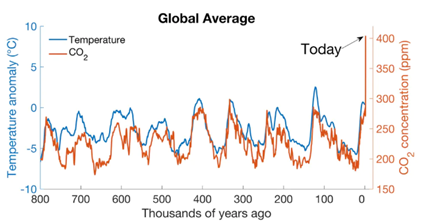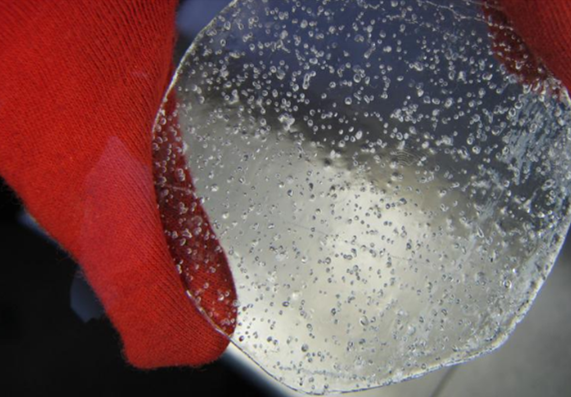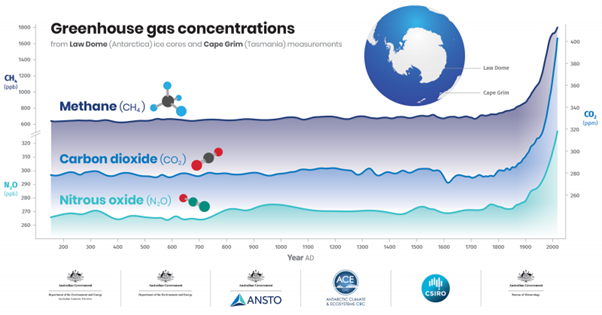
Dr Krystyna Saunders
Questions answered by this expert
The climate was always changing, but it is important to understand that there is a big difference between natural climate change (or climate variability) and climate change due to human activities.
Natural climate change
Past natural climate changes have led to the extinction of many species, caused populations to migrate, as well as large changes to land temperatures, the amount of carbon dioxide and other greenhouse gases in the atmosphere, and ocean currents. In the last 800,000 years, for example, the Earth has gone through seven glacial cycles (ice ages), where the Earth was much cooler than today with expansive ice sheets covering much of the globe. At the end of each of these, the climate warmed, in some cases to warmer temperatures than today. The timing of these cycles is mostly controlled by slow changes in Earth’s orbit, which alter the way the Sun’s energy is distributed around the Earth.
Human-caused climate change
Humans have always affected and modified their environment but over the last 200 years, however, human activities have increasingly overridden natural climate processes, and since at least the middle of the 20th century, the warming we are seeing is undeniably a result of human activities. Our actions are causing rising carbon dioxide concentrations to levels higher than at any time in at least the last 800,000 years (see figure below), and rising temperatures in the atmosphere, ocean and on land are at a scale and rate never seen before. This is leading to the increasing frequency and intensity of extreme events such as bushfires, cyclones, heatwaves, floods and droughts we are experiencing.

Climate change is caused by natural processes but also increasingly by human activities. The main driver of climate change is the greenhouse effect. Some gases in the atmosphere have a similar function to the glass in a greenhouse. The glass walls of a greenhouse let heat and light from the Sun in, which warms up the air inside. Similarly, greenhouse gases let the incoming heat from the Sun pass through to the Earth’s surface, where it is trapped. Many of these gases occur naturally, and natural causes of changes to the greenhouse effect include solar radiation and volcanic activity. But human activities are increasing the concentrations of some greenhouse gases in the atmosphere, in particular carbon dioxide, methane, nitrous oxide and fluorinated gases, leading to an enhanced greenhouse effect and warmer temperatures.
The main human activities causing these changes are:
- Burning of fossil fuels such as coal, oil and gas, which produce carbon dioxide and nitrous oxide
- Deforestation, which means that there are less trees to help absorb carbon dioxide from the atmosphere, and carbon stored in the trees is released to the atmosphere
- Increasing livestock farming, which is problematic as cows and sheep, for example, produce large amounts of methane when they digest their food
- Fertilisers containing nitrogen, which produce nitrous oxide emissions
- Fluorinated gases, which are emitted from equipment and products that use these gases, such as refrigerators, air conditioners and heat pumps
While natural processes play a role in how the climate changes, what we are currently experiencing cannot be explained by natural processes alone. Since at least the mid 20th century, humans are unequivocally causing climate change, and unless we modify how we live and how we interact with the environment around us, this will continue to be the case.
Understanding past climates involves studying naturally occurring archives such as ice cores, tree rings and lake sediments, among others, from around the world including Tasmania and Antarctica. Each of these archives accumulate layers over time. This is similar to the pages of a book, where each page represents a particular period of time and each page tells you something different. Using many different chemical, geological, biological and physical methods, it is possible to reconstruct what the climate was like in the past.

Ice cores can be used to measure past greenhouse gas concentrations, such as carbon dioxide and methane. These gases are trapped in air bubbles in the ice (see photo). Layers of ice can accumulate annually, which means the ice cores trap a record of greenhouse gas concentrations year by year. It is from these concentrations that it is possible to calculate the percentages of different greenhouse gases, including methane. The figure below shows the concentrations of the major greenhouse gases: methane, carbon dioxide and nitrous oxide over the last 2000 years. It is clear that since the 1800s, concentrations have sharply risen and will continue to rise unless we make dramatic changes to reduce emissions.

A great read: Dr Karl’s Little Book of Climate Change Science by Karl Kruszelnicki (2021, ABC Books)









